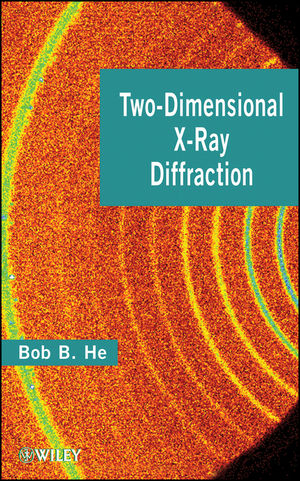
Two–Dimensional X–Ray Diffraction
Wiley-Blackwell (Verlag)
978-0-470-22722-0 (ISBN)
- Titel erscheint in neuer Auflage
- Artikel merken
Written by one of the pioneers of 2D X-Ray Diffraction, this useful guide covers the fundamentals, experimental methods and applications of two-dimensional x-ray diffraction, including geometry convention, x-ray source and optics, two-dimensional detectors, diffraction data interpretation, and configurations for various applications, such as phase identification, texture, stress, microstructure analysis, crystallinity, thin film analysis and combinatorial screening. Experimental examples in materials research, pharmaceuticals, and forensics are also given. This presents a key resource to researchers in materials science, chemistry, physics, and pharmaceuticals, as well as graduate-level students in these areas.
Bob Baoping He is the Director of R&D and Engineering at Bruker AXS (formerly Siemens AXS). Mr. He holds a PhD in materials science from Virginia Tech and holds twelve U.S. patents.
Preface. 1. Introduction. 1.1 X-Ray Technology and Its Brief History. 1.2 Geometry of Crystals. 1.3 Principles of X-Ray Diffraction. 1.4 Reciprocal Space and Diffraction. 1.5 Two-Dimensional X-Ray Diffraction. 2. Geometry Conventions. 2.1 Introduction. 2.2 Diffraction Space and Laboratory Coordinates. 2.3 Detector Space and Detector Geometry. 2.4 Sample Space and Goniometer Geometry. 2.5 Transformation from Diffraction Space to Sample Space. 2.6 Summary of XRD2 Geometry. References. 3. X-Ray Source and Optics. 3.1 X-Ray Generation and Characteristics. 3.2 X-Ray Optics. References. 4. X-Ray Detectors. 4.1 History of X-Ray Detection Technology. 4.2 Point Detectors in Conventional Diffractometers. 4.3 Characteristics of Point Detectors. 4.4 Line Detectors. 4.5 Characteristics of Area Detectors. 4.6 Types of Area Detectors. 5. Goniometer and Sample Stages. 5.1 Goniometer and Sample Position. 5.2 Goniometer Accuracy. 5.3 Sample Alignment and Visualization Systems. 5.4 Environment Stages. References. 6. Data Treatment. 6.1 Introduction. 6.2 Nonuniform Response Correction. 6.3 Spatial Correction. 6.4 Detector Position Accuracy and Calibration. 6.5 Frame Integration. 6.6 Lorentz, Polarization, and Absorption Corrections. 7. Phase Identification. 7.1 Introduction. 7.2 Relative Intensity. 7.3 Geometry and Resolution. 7.4 Sampling Statistics. 7.5 Preferred Orientation Effect. References. 8. Texture Analysis. 8.1 Introduction. 8.2 Pole Density and Pole Figure. 8.3 Fundamental Equations. 8.4 Data Collection Strategy. 8.5 Texture Data Process. 8.6 Orientation Distribution Function. 8.7 Fiber Texture. 8.8 Other Advantages of XRD2 for Texture. References. 9. Stress Measurement. 9.1 Introduction. 9.2 Principle of X-Ray Stress Analysis. 9.3 Theory of Stress Analysis with XRD2. 9.4 Process of Stress Measurement with XRD2. 9.5 Experimental Examples. Appendix 9.A Calculation of Principal Stresses from the General Stress Tensor. Appendix 9.B Parameters for Stress Measurement. References. 10. Small-Angle X-Ray Scattering. 10.1 Introduction. 10.2 2D SAXS Systems. 10.3 Application Examples. 10.4 Some Innovations in 2D SAXS. References. 11. Combinatorial Screening. 11.1 Introduction. 11.2 XRD2 Systems for Combinatorial Screening. 11.3 Combined Screening with XRD2 and Raman. 12. Quantitative Analysis. 12.1 Percent Crystallinity. 12.2 Crystal Size. 12.3 Retained Austenite. References. 13. Innovation and Future Development. 13.1 Introduction. 13.2 Scanning Line Detector for XRD2. 13.3 Three-Dimensional Detector. 13.4 Pixel Direct Diffraction Analysis. References. Appendix A. Values of Commonly Used Parameters. Appendix B. Symbols. Index.
| Erscheint lt. Verlag | 4.9.2009 |
|---|---|
| Verlagsort | Hoboken |
| Sprache | englisch |
| Maße | 168 x 240 mm |
| Gewicht | 776 g |
| Themenwelt | Naturwissenschaften ► Chemie ► Analytische Chemie |
| Naturwissenschaften ► Geowissenschaften ► Mineralogie / Paläontologie | |
| Technik ► Maschinenbau | |
| ISBN-10 | 0-470-22722-2 / 0470227222 |
| ISBN-13 | 978-0-470-22722-0 / 9780470227220 |
| Zustand | Neuware |
| Haben Sie eine Frage zum Produkt? |
aus dem Bereich



